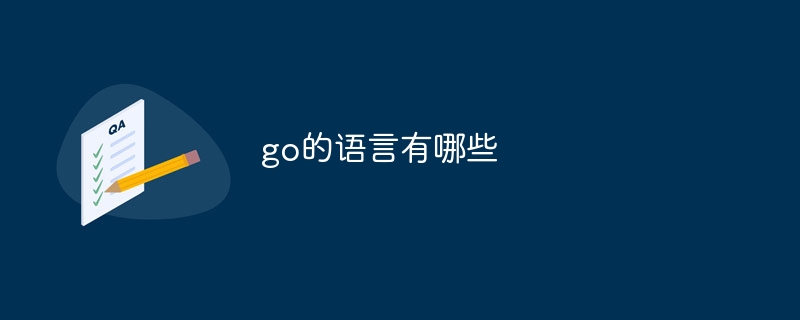
Go's language has basic types, arrays, slices, dictionaries, structures, interfaces, functions, channels and receivers. 1. Basic types, including Boolean, integer, unsigned integer, floating point, etc.; 2. Array, a data structure with fixed length and consistent type; 3. Slicing, implemented based on array, can be derived from existing Created in an array or slice; 4. Dictionary, used to store and retrieve data, very suitable for building fast lookup tables; 5. Structure, used to combine multiple fields of different types. The fields of a structure can be of any type, etc.

The operating environment of this tutorial: windows10 system, golang1.20.1 version, DELL G3 computer.
The Go language has many types that can be used to define variables, function parameters, function return values, and members of data structures. Below are some common Go language types.
1. Basic type (Basic types): Go language provides some basic types, including Boolean (bool), integer (int, int8, int16, int32, int64), unsigned integer (uint, uint8, uint16, uint32, uint64), floating point Type (float32, float64), complex type (complex64, complex128), string type (string) and byte type (byte, rune).
2. Array: Array in Go language is a data structure with fixed length and consistent type. For example, you can use `var arr [5]int` declares an integer array of length 5.
3. Slice: A slice is a dynamic array whose length can be changed at any time. Slices are implemented based on arrays and can be created from existing arrays or slices.
4. Dictionary (Map): A dictionary is an unordered collection of key-value pairs, in which each key uniquely corresponds to a value. Dictionaries can be used to store and retrieve data, making them ideal for building fast lookup tables.
5. Structure (Struct): Structure is a custom data type used to combine multiple fields of different types. The fields of a structure can be of any type.
6. Interface: An interface is an abstract type that describes the behavior of an object. An interface defines a set of methods. An object is considered to implement the interface as long as it implements all methods of the interface.
7. Function: Functions in the Go language are first-class citizens and can be passed as parameters, assigned to variables, and returned as return values. Functions can also be defined as methods, associated with a specified type.
8. Channel: A channel is a pipe used to transmit data and is used to coordinate concurrent operations. Channels can be used to transfer data between different goroutines to achieve data synchronization and communication.
9. Receiver: The receiver is a special parameter associated with a method, which specifies the caller type of the method. The receiver can be a value receiver (value receiver) or pointer receiver.
The above are some common Go language types, each type has its own characteristics and uses. Developers can choose appropriate types in code to store and operate data based on actual needs.
The above is the detailed content of What are the languages for go?. For more information, please follow other related articles on the PHP Chinese website!
 Usage of Type keyword in Go
Usage of Type keyword in Go
 How to implement linked list in go
How to implement linked list in go
 What are the Go language programming software?
What are the Go language programming software?
 How to learn go language from 0 basics
How to learn go language from 0 basics
 What are the methods to implement operator overloading in Go language?
What are the methods to implement operator overloading in Go language?
 What are the operators in Go language?
What are the operators in Go language?
 How to learn go language from 0 basics
How to learn go language from 0 basics
 How to configure database connection in mybatis
How to configure database connection in mybatis




